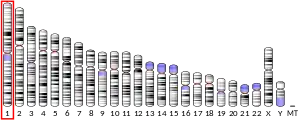Tm2 domain containing 1
TM2 domain containing 1 is a protein that in humans is encoded by the TM2D1 gene. [5]
| TM2D1 | |||||||||||||||||||||||||||||||||||||||||||||||||||
|---|---|---|---|---|---|---|---|---|---|---|---|---|---|---|---|---|---|---|---|---|---|---|---|---|---|---|---|---|---|---|---|---|---|---|---|---|---|---|---|---|---|---|---|---|---|---|---|---|---|---|---|
| Identifiers | |||||||||||||||||||||||||||||||||||||||||||||||||||
| Aliases | TM2D1, BBP, TM2 domain containing 1 | ||||||||||||||||||||||||||||||||||||||||||||||||||
| External IDs | OMIM: 610080 MGI: 2137022 HomoloGene: 12928 GeneCards: TM2D1 | ||||||||||||||||||||||||||||||||||||||||||||||||||
| |||||||||||||||||||||||||||||||||||||||||||||||||||
| |||||||||||||||||||||||||||||||||||||||||||||||||||
| |||||||||||||||||||||||||||||||||||||||||||||||||||
| |||||||||||||||||||||||||||||||||||||||||||||||||||
| |||||||||||||||||||||||||||||||||||||||||||||||||||
| Wikidata | |||||||||||||||||||||||||||||||||||||||||||||||||||
| |||||||||||||||||||||||||||||||||||||||||||||||||||
Function
The protein encoded by this gene is a beta-amyloid peptide-binding protein. It contains a structural module related to that of the seven transmembrane domain G protein-coupled receptor superfamily and known to be important in heterotrimeric G protein activation. Beta-amyloid peptide has been established to be a causative factor in neuron death and the consequent diminution of cognitive abilities observed in Alzheimer's disease. This protein may be a target of neurotoxic beta-amyloid peptide, and may mediate cellular vulnerability to beta-amyloid peptide toxicity through a G protein-regulated program of cell death. Several transcript variants have been found for this gene.
References
- GRCh38: Ensembl release 89: ENSG00000162604 - Ensembl, May 2017
- GRCm38: Ensembl release 89: ENSMUSG00000028563 - Ensembl, May 2017
- "Human PubMed Reference:". National Center for Biotechnology Information, U.S. National Library of Medicine.
- "Mouse PubMed Reference:". National Center for Biotechnology Information, U.S. National Library of Medicine.
- "Entrez Gene: TM2 domain containing 1". Retrieved 2017-05-19.
Further reading
- Kirfel G, Borm B, Rigort A, Herzog V (2002). "The secretory beta-amyloid precursor protein is a motogen for human epidermal keratinocytes". Eur. J. Cell Biol. 81 (12): 664–76. doi:10.1078/0171-9335-00284. PMID 12553667.
- Lee Y, Chang DJ, Lee YS, Chang KA, Kim H, Yoon JS, Lee S, Suh YH, Kaang BK (2003). "Beta-amyloid peptide binding protein does not couple to G protein in a heterologous Xenopus expression system". J. Neurosci. Res. 73 (2): 255–9. doi:10.1002/jnr.10652. PMID 12836168. S2CID 32419466.
This article incorporates text from the United States National Library of Medicine, which is in the public domain.



